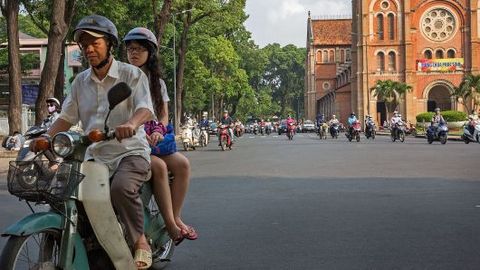Analyses & Etudes
Vietnam shines despite Southeast Asia's struggles with trade and emerging market pressures

-Vietnam is defying the stress in emerging markets as its Southeast Asian rivals face an uncertain outlook driven by trade war risks and a stronger dollar. -Vietnam received an estimated $11.25 billion in foreign direct investment in the January to August period of 2018, up 9.2 percent from the same period a year earlier, the investment ministry said last month. -But policymakers must ensure the country's budget deficit doesn't blow out and the economy doesn't overheat, one expert says.
Vietnam — with its economy growing at its fastest pace in eight years in the first half of 2018 — is defying the stress in emerging markets as its Southeast Asian rivals face an uncertain outlook driven by trade war risks and a stronger dollar.
The threat of an escalating global trade conflict is weighing on prospects for export-dependent economies like Singapore and Malaysia, while Indonesia and the Philippines face challenges funding their high levels of external debt as their currencies come under pressure from a rising U.S. dollar.
Despite the spillover into Asia, Vietnam's geographical proximity to China and its historically strong political and economic links with Beijing are paying dividends. Facing cost pressures created by U.S. trade tariffs, Chinese manufacturers are starting to shift production away from the mainland into cheaper Asian locations such as Vietnam and Bangladesh. South Korean, Japanese and Taiwanese firms are already invested in Vietnam.
Many of the countries in ASEAN — the Association of Southeast Asian Nations — are in a far stronger economic position than during the financial crisis of the late 1990s. But the latest fluctuations from emerging market worries, together with global trade frictions, raise questions about who will be impacted the hardest, what the contagion risk for the region will be like, and how best to limit the impact of outflows and currency weakness.
Policymakers and business leaders meeting in Hanoi at the World Economic Forum on ASEAN will attempt to discuss ways to mitigate what Mizuho strategists call a "double-barrelled U.S. shotgun" of a more hawkish Federal Reserve and U.S. President Donald Trump"upping the ante on trade war risks."
"What we are looking at now is a sign of regional EM (emerging markets) differentiation, because certain markets don't warrant the negativity," said Dwyfor Evans, the head of Asia Pacific macro strategy at State Street Global Markets.
"If the U.S. is unable to offset lower Chinese imports by reshoring manufacturing, then continued strong demand conditions in the U.S. will have to be met from alternative sources," he said. "I will not import toys from China. Instead, I will import from Vietnam, so trade wars and protectionism actually end up as a positive for Vietnam."
Foreign investors
Vietnam received an estimated $11.25 billion in foreign direct investment (FDI) in the January to August period, up 9.2 percent from the same period a year earlier, the investment ministry said last month. In 2017, Vietnam received a record $17.5 billion in FDI.
"A lot of companies are relocating," said Robert Subbaraman, head of emerging markets economics at Nomura told CNBC on Monday. "FDI inflows in particular have been very strong and have been providing good balance of payment support for Vietnam."
Though current fundamentals look "pretty good," Subbaraman said Vietnam must exercise caution on the fiscal front. Policymakers must ensure the budget deficit doesn't blow out and the economy doesn't overheat. "That often happens when you get the very strong inflows and companies moving in."
Michael Langford, executive director at Airguide, a corporate advisory and consultancy, said Sino-U.S. trade tensions "politically will tighten the relationship between China and Vietnam."
"Many Chinese firms have factories located in Vietnam now. Companies from battery manufacturers like Vision, through to furniture and textile manufacturing," he added.
Vietnam may yet be a victim of its own success as it moves up the value chain from low-margin textiles to high-tech products.
"Binary risks around growth are intensifying as a protectionist U.S. puts the key exports engine at the risk of sputtering abruptly," said Mizuho's Vishnu Varathan in regional economic quarterly research published on Aug. 7. "We expect that longer term boost to inward investments into Vietnam remains a compelling proposition; as the natural 'flow down' of industries from China is hastened by trade war risks."
Vietnam is a heavily trade-dependent economy with a trade-to-GDP ratio of approximately 200 percent "and rising," according to Standard Chartered Bank economist, Chidu Narayanan.
Still, FDI inflows are set to remain high in 2018, led by manufacturing which makes up close to 50 percent of inflows, Narayanan said in research published in late June.
Standard Chartered expects both registered and implemented FDI to be close to $15 billion in 2018, moderating from $21 billion in 2017, he said.
"Vietnam has benefited from its participation in regional trade pacts, a young and educated population, a still-cheap and growing labour force, and geographical proximity to China," he said.
"This should continue to attract strong FDI inflows in the coming years."
Source: cnbc.com


